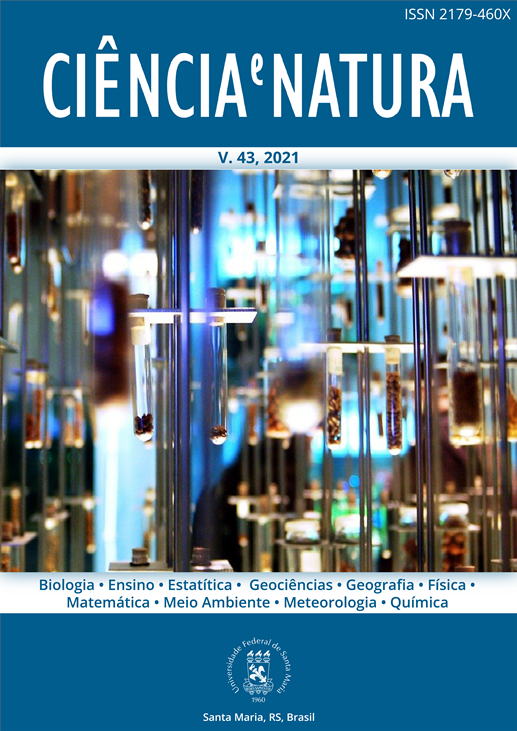Aplicação do Efeito Peltier-Seebeck para conversão de Energia Térmica-Elétrica como fonte de carregamento de um dispositivo móvel
DOI:
https://doi.org/10.5902/2179460X40858Palavras-chave:
Energia renovável, Física aplicada, Efeito PeltierResumo
No presente trabalho, apresenta-se um meio viável, utilizando componentes de baixo custo e energia renovável, de construir um carregador de celular com fonte principal de energia obtida a partir da diferença de temperatura entre um corpo humano e um dissipador de calor, independente de fios e/ou conectores externos. Utilizando o efeito Peltier-Seeback, para produzir uma diferença de potencial a partir da junção de condutores em temperaturas diferentes, estabilizando e amplificando esta com um circuito composto por componentes simples e de fácil acesso, obtivemos como saída do circuito os valores médios de 5,02 V e 1.1A. Tais valores podem ser considerados suficientes para recarregar uma bateria de smartphone, que variam seus valores de saída entre 3.3V-5V e 0.7A-2A. Desse modo, o estudo apresentado demonstra a aplicação de um efeito termo-físico a um acessório de uso cotidiano, utilizando como intermeio o conceito básico de engenharia que se refere a solução de problemas. Assim, mediante a situações de escassez de energia elétrica surgem novas frentes de pesquisa que poderão ser utilizadas de forma ampliada para permitir o abastecimento de energia em eletrodomésticos de alta tensão, levar suprimento de energia a locais remotos e contribuir para o desenvolvimento de pesquisas nessa área.
Downloads
Referências
MACDONALD, D. K. C. Thermoelectricity: An Introduction to the Principles. 1. ed. NewYork: Dover Publications. 2006.
DUTRA, F. A história do telefone celular como distinção social no Brasil. Da elite empresarial ao consumo da classe popular. Revista Brasileira de História da Mídia. (Vol. 05 – Nº02. Jul/Dez. 2016.
HOFFMAN, C. Why Is Smartphone Battery Life Still So Bad?. How-ToGeek. Informatic. 22 sep. 2016. Available in: <https://goo.gl/n4foMx>. Access in 12 jul. 2017. São Paulo, Brazil.
CEKDIN, C. The usage of thermoelectric generator as a renewable energy source. TELKOMNIKA Telecommunication, Computing, Electronics and Control. Vol. 18, No. 4, August 2020.
MOURA, J. A. S. Filmes nanométricos de fen e aln crescidos por sputtering e aplicações do efeito Peltier. 131f. Tese (Doutorado em programa de pós-graduação em Física) - Universidade Federal do Rio Grande do Norte, Natal-RN, Brazil, 2010.
FEYNMAN, R.P. The Feynman Lectures on Physics. 2. ed. Boston: Addison-Wesley. 1964.
PISCHKEA E. From Kyoto to Paris: Measuring renewable energy policy regimes in Argentina, Brazil, Canada, Mexico and the United States. Energy Research & Social Science Volume 50, 2019.
KUMAR, S. Thermal Analysis and Performance Evaluation of Peltier Module. Renewable Energy and its Innovative Technologies. 2018.
SPRY, M. RETHINKING THERMOELECTRIC EFFECTS IN SEEBECK AND PELTIER ELEMENTS. 2. ed. USA: Create Space Independent Publishing Platform. 2013.
REIS, M.S. Implementação de um Regulador de Tensão com Comutador Eletrônico de Tap. Rio de Janeiro - UFRJ/COPPE, 2013.
SCI LLC. Semiconductor Components Industries, LLC. MC7800, MC7800A, MC7800AE, NCV7800 Datasheet. Available in: <https://goo.gl/mH7SvX> Access in 5 aug. 2016. Colorado, USA, 2014.
INCB. Instituto Newton C. Braga. Como funcionam os carregadores de baterias. Eletronic. 2010. Available in: <https://goo.gl/eXQNdL>. Access in 9 sep. 2016. São Paulo, Brazil.
WANG, X. Direct thermal charging cell for converting low-grade heat to electricity. Nat Commun 10, 4151. 2019.
OGIN, G. How much heat per hour do humans dissipate?. PhysLink. Physics. 2011. Available in: https://goo.gl/Xe8PGx>. Acces in 23 aug. 2016. New York, USA.
GOLDSMID, J. Physics of Thermoelectric Energy Conversion (Iop Concise Physics). 1. e.d. USA: IOP Concise Physics. 2017.
WIDLAR, R. (1971). New Devopments in IC Voltage Regulators. IEEE Journal of Solid-State Circuits, VOL. SC-6 NO 1. (FEBRUARY 1971). New York, USA, 1971.
Downloads
Publicado
Como Citar
Edição
Seção
Licença
Para acessar a DECLARAÇÃO DE ORIGINALIDADE E EXCLUSIVIDADE E CESSÃO DE DIREITOS AUTORAIS clique aqui.
Diretrizes Éticas para Publicação de Revistas
A revista Ciência e Natura está empenhada em garantir a ética na publicação e na qualidade dos artigos.
A conformidade com padrões de comportamento ético é, portanto, esperada de todas as partes envolvidas: Autores, Editores e Revisores.
Em particular,
Autores: Os Autores devem apresentar uma discussão objetiva sobre a importância do trabalho de pesquisa, bem como detalhes e referências suficientes para permitir que outros reproduzam as experiências. Declarações fraudulentas ou intencionalmente incorretas constituem comportamento antiético e são inaceitáveis. Artigos de Revisão também devem ser objetivos, abrangentes e relatos precisos do estado da arte. Os Autores devem assegurar que seu trabalho é uma obra totalmente original, e se o trabalho e / ou palavras de outros têm sido utilizadas, isso tem sido devidamente reconhecido. O plágio em todas as suas formas constitui um comportamento publicitário não ético e é inaceitável. Submeter o mesmo manuscrito a mais de um jornal simultaneamente constitui um comportamento publicitário não ético e é inaceitável. Os Autores não devem submeter artigos que descrevam essencialmente a mesma pesquisa a mais de uma revista. O Autor correspondente deve garantir que haja um consenso total de todos os Co-autores na aprovação da versão final do artigo e sua submissão para publicação.
Editores: Os Editores devem avaliar manuscritos exclusivamente com base no seu mérito acadêmico. Um Editor não deve usar informações não publicadas na própria pesquisa do Editor sem o consentimento expresso por escrito do Autor. Os Editores devem tomar medidas de resposta razoável quando tiverem sido apresentadas queixas éticas relativas a um manuscrito submetido ou publicado.
Revisores: Todos os manuscritos recebidos para revisão devem ser tratados como documentos confidenciais. As informações ou ideias privilegiadas obtidas através da análise por pares devem ser mantidas confidenciais e não utilizadas para vantagens pessoais. As revisões devem ser conduzidas objetivamente e as observações devem ser formuladas claramente com argumentos de apoio, de modo que os Autores possam usá-los para melhorar o artigo. Qualquer Revisor selecionado que se sinta desqualificado para rever a pesquisa relatada em um manuscrito ou sabe que sua rápida revisão será impossível deve notificar o Editor e desculpar-se do processo de revisão. Os Revisores não devem considerar manuscritos nos quais tenham conflitos de interesse resultantes de relacionamentos ou conexões competitivas, colaborativas ou outras conexões com qualquer dos autores, empresas ou instituições conectadas aos documentos.






